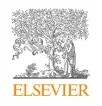JACI:纤维素上的CCD表位是ImmunoCAP过敏检测中出现假阳性结果的原因之一
发布日期:2018-11-13
原标题:ImmunoCAP所用纤维素含有碳水化合物交叉反应决定簇(CCD)表位,在有高抗CCD IgE抗体水平的病人中能引起假阳性的检测结果

延伸阅读

JACI
https://doi.org/10.1016/j.jaci.2017.04.028
Abstract:
Background
Cross-reactive carbohydrate determinants (CCDs) in plants and insect venoms are a common cause of irrelevant positive test results during in vitro allergy diagnosis. We observed that some CCD-positive sera show nonspecific IgE binding even with CCD-free recombinant allergens when using the Phadia ImmunoCAP platform.
Objective
We investigated whether cellulose used as an allergen carrier in ImmunoCAP harbors residual N-glycans, causing nonspecific background binding in CCD-positive sera.
Methods
IgE binding to 6 samples of blank ImmunoCAPs coupled to either streptavidin (SA-CAP-1 or 2) or nonallergenic maltose-binding protein (MBP; MBP-CAP-1 to 4) and binding to a panel of 4 recombinant allergens were compared in CCD-positive sera before and after inhibition with a CCD inhibitor (MUXF3–human serum albumin).
Results
Of 52 CCD-positive sera (bromelain, 1.01-59.6 kilounits of antigen per liter [kUA/L]) tested on SA-CAP-1, 35 (67%) showed IgE binding of greater than 0.35 kUA/L (0.41-4.22 kUA/L).
Among those with anti-CCD IgE levels of greater than 7.0 kUA/L, 90% (26/29) were positive. IgE binding to SA-CAP-1 correlated with IgE binding to bromelain (r = 0.68) and was completely abolished by serum preincubation with the CCD inhibitor (n = 15). Binding scores with SA-CAP-2 and MBP-CAP-1 to MBP-CAP-4 were generally lower but strongly correlated with those of SA-CAP-1 and bromelain. IgE reactivity of 10 CCD-positive sera (14.0-52.5 kUA/L) with the recombinant allergens rPhl p 12, rFel d 1, rAra h 2, and rPru p 3 was positive to at least 1 allergen in 8 of 10 (0.36-1.63 kUA/L) and borderline in 2 of 10 (0.21-0.25 kUA/L). Binding correlated with antibody binding to bromelain (r = 0.61) and to all blank ImmunoCAPs (r > 0.90) and could be completely blocked by the CCD inhibitor. Overall, mean background binding to cellulose CCDs corresponded to 2% to 3% of the reactivity seen with bromelain.
Conclusions
Cellulose used as a solid-phase allergen carrier can contain varying amounts of CCDs sufficient to cause false-positive test results up to 2 kUA/L with nonglycosylated recombinant allergens in patients with high levels of anti-CCD IgE antibodies.
All Authors:
lWolfgangHemmerPhDaFriedrichAltmannPhDbFriedrichHolzweberMDcClemensGruberPhDbFelixWantkeMDaStefanWöhrlMD, MSca


——来自浙大迪迅
①植物和昆虫毒液中交叉反应性碳水化合物决定因子(CCDs)是体外过敏诊断中假阳性检测结果的常见原因。我们观察到,在使用Phadia ImmunoCAP平台时,一些CCD阳性血清甚至与无CCD的重组变应原发生非特异性IgE结合。②我们研究了ImmunoCAP中作为过敏原蛋白载体的纤维素中是否隐藏有N –多糖残基,在CCD阳性血清中引起非特异性结合。③在CCD阳性血清中,在应用CCD抑制剂(MUXF3–人血清白蛋白)进行抑制前后,对IgE与偶联有链霉亲和素(SA-CAP-1 或 2)或非过敏性麦芽结合蛋白(MBP; MBP-CAP-1 至 4)的6种空白ImmunoCAP样本结合能力以及IgE与4种重组过敏原的结合能力进行比较。③在SA-CAP-1检测的52例CCD阳性血清(菠萝蛋白酶, 1.01-59.6 kUA/L)中,35例(67%)IgE结合大于0.35 kUA/L (0.41-4.22 kUA/L)。在抗CCD IgE水平大于7.0 kUA/L的人群中,90%(26/29)为阳性。IgE与SA-CAP-1的结合能力与IgE与菠萝蛋白酶的结合能力有相关性(r = 0.68),通过血清与CCD抑制剂的预孵育完全消除(n = 15)。与SA-CAP-2和MBP-CAP-1至MBP-CAP-4的结合能力普遍较低,但与SA-CAP-1和菠萝蛋白酶的结合能力密切相关。10个CCD阳性血清(14.0-52.5 kUA/L)与重组过敏原rPhl p 12, rFel d 1, rAra h 2, 和 rPru p 3IgE反应性显示,有8个至少对一种呈阳性(0.36-1.63 kUA/L),其余2个的值也在临界附近(0.21-0.25 kUA/L)。结合程度与抗体和菠萝蛋白酶的结合程度相关(r=0.61),也与和所有空白ImmunoCAPs的结合相关(r=0.90),并且能完全被CCD抑制剂阻止,总体来说,与纤维素CCD的平均结合作用相当于与菠萝蛋白酶反应能力的2% - 3%。④纤维素作为一种固相过敏原载体,可含有不同数量的CCD,足以导致在抗CCD IgE抗体水平较高的患者中,非糖基化重组过敏原的假阳性检测结果高达2 KUA/L。
延伸阅读

JACI
[IF:13.1]
ImmunoCAP cellulose displays cross-reactive carbohydrate determinant (CCD) epitopes and can cause false-positive test results in patients with high anti-CCD IgE antibody levelshttps://doi.org/10.1016/j.jaci.2017.04.028
Abstract:
Background
Cross-reactive carbohydrate determinants (CCDs) in plants and insect venoms are a common cause of irrelevant positive test results during in vitro allergy diagnosis. We observed that some CCD-positive sera show nonspecific IgE binding even with CCD-free recombinant allergens when using the Phadia ImmunoCAP platform.
Objective
We investigated whether cellulose used as an allergen carrier in ImmunoCAP harbors residual N-glycans, causing nonspecific background binding in CCD-positive sera.
Methods
IgE binding to 6 samples of blank ImmunoCAPs coupled to either streptavidin (SA-CAP-1 or 2) or nonallergenic maltose-binding protein (MBP; MBP-CAP-1 to 4) and binding to a panel of 4 recombinant allergens were compared in CCD-positive sera before and after inhibition with a CCD inhibitor (MUXF3–human serum albumin).
Results
Of 52 CCD-positive sera (bromelain, 1.01-59.6 kilounits of antigen per liter [kUA/L]) tested on SA-CAP-1, 35 (67%) showed IgE binding of greater than 0.35 kUA/L (0.41-4.22 kUA/L).
Among those with anti-CCD IgE levels of greater than 7.0 kUA/L, 90% (26/29) were positive. IgE binding to SA-CAP-1 correlated with IgE binding to bromelain (r = 0.68) and was completely abolished by serum preincubation with the CCD inhibitor (n = 15). Binding scores with SA-CAP-2 and MBP-CAP-1 to MBP-CAP-4 were generally lower but strongly correlated with those of SA-CAP-1 and bromelain. IgE reactivity of 10 CCD-positive sera (14.0-52.5 kUA/L) with the recombinant allergens rPhl p 12, rFel d 1, rAra h 2, and rPru p 3 was positive to at least 1 allergen in 8 of 10 (0.36-1.63 kUA/L) and borderline in 2 of 10 (0.21-0.25 kUA/L). Binding correlated with antibody binding to bromelain (r = 0.61) and to all blank ImmunoCAPs (r > 0.90) and could be completely blocked by the CCD inhibitor. Overall, mean background binding to cellulose CCDs corresponded to 2% to 3% of the reactivity seen with bromelain.
Conclusions
Cellulose used as a solid-phase allergen carrier can contain varying amounts of CCDs sufficient to cause false-positive test results up to 2 kUA/L with nonglycosylated recombinant allergens in patients with high levels of anti-CCD IgE antibodies.
All Authors:
lWolfgangHemmerPhDaFriedrichAltmannPhDbFriedrichHolzweberMDcClemensGruberPhDbFelixWantkeMDaStefanWöhrlMD, MSca
2018-11-10 Article
创建过敏性疾病的科研、科普知识交流平台,为过敏患者提供专业诊断、治疗、预防的共享平台。

开云电子(中国)官方网站 | 华亿首页(中国)网页版 | 开云网页版 | 天博手机网页(中国)有限公司 | 千亿体育线上平台中国有限公司 | 米兰手机在线登入 | 米乐官方网页版 | 华亿网页版 | 三亿体育首页(中国)网站首页 |
 华亿体育(中国)游戏平台
华亿体育(中国)游戏平台

